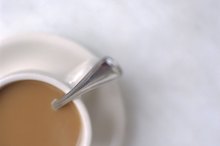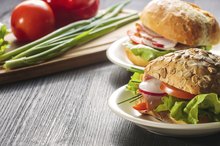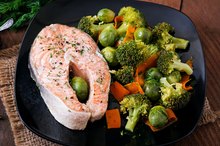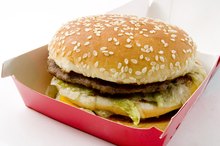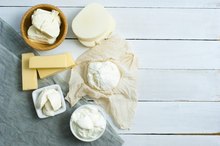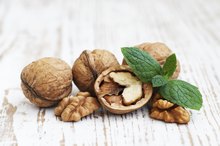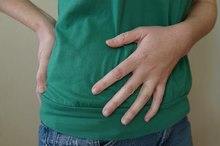Recommended Diet to Deal with Gallstones and Biliary Colic
Biliary colic is the result of an inflamed gallbladder caused by a blocked bile or cystic duct 12. This condition is characterized by the rapid onset of intense pain on the right side under the rib cage, which may radiate to the upper back. An attack can last for a few minutes or several hours and may be accompanied by nausea and vomiting. Dietary modifications may reduce the frequency and severity of attacks, but talk to your doctor before starting a diet plan.
If you are experiencing serious medical symptoms, seek emergency treatment immediately.
Importance of Diet
The gallbladder produces a special liquid called bile or gall, which contains water, salts and chemicals like bilirubin to break down fats. In a healthy gallbladder, bile is able to freely enter the small intestine via bile ducts and cystic ducts, the go-between channels that bridge the gallbladder and main bile ducts. Bile supply varies with demand. A certain amount of bile is secreted every time you eat, but exactly how much depends on the amount of fat in your meal. If a gallstone impairs bile flow, biliary colic results until the stone either passes or is surgically removed 12. Even though symptoms may subside after an attack, they will likely reoccur until this situation is resolved. Diet is one way to prevent gallstones and biliary colic from coming back 12.
- The gallbladder produces a special liquid called bile or gall, which contains water, salts and chemicals like bilirubin to break down fats.
Weight Maintenance
Should Alcohol and Caffeine Be Avoided After Gallbladder Removal?
Learn More
If you are overweight, you may have an increased risk of developing gallstones and biliary colic 12. However, losing weight too quickly can also promote gallstone formation; a reasonable weight-loss goal is 1 to 2 pounds a week, according to the Weight-Control Information Network 3. Periods of fasting followed by eating a large amount of food can trigger biliary colic if you already have gallstones 12. Similarly, try not to skip meals. To avoid these complications, ask your doctor or a nutritionist to help you design a weight-loss plan that allows you to shed pounds slowly and consistently.
Foods to Avoid
Remember the supply vs. demand rule: the more fats you consume, the greater the output of bile from your gallbladder. Therefore, limit the amount of fat and low-density cholesterol in your diet. According to the American Heart Association, your total daily intake of cholesterol should not exceed 300 milligrams. If you have been diagnosed with heart disease, or your LDL or bad cholesterol is over 100, you need to limit your intake to 200 milligrams. Avoid trans fat, which means limiting fried foods, cookies, crackers and many kinds of snacks.
- Remember the supply vs. demand rule: the more fats you consume, the greater the output of bile from your gallbladder.
- If you have been diagnosed with heart disease, or your LDL or bad cholesterol is over 100, you need to limit your intake to 200 milligrams.
Foods to Increase
A Diet for After Your Gallbladder Has Been Taken Out
Learn More
Choose low-fat dairy products or non-dairy alternatives like egg substitutes. Certain nuts and seeds such as walnuts, flaxseeds and almonds may help ward off gallstones and biliary colic because they are high in omega-3 fatty acids, which can help to reduce levels of LDL cholesterol 12.
Related Articles
References
- Drugs: Biliary Colic
- Abraham S, Rivero HG, Erlikh IV, et al. Surgical and nonsurgical management of gallstones. Am Fam Physician. 2014;89(10):795-802.
- Wittenburg H. Hereditary liver disease: gallstones. Best Pract Res Clin. Gastroenterol. 2010;24(5):747-756. doi:10.1016/j.bpg.2010.07.004
- Dadhwal US, Kumar V. Benign bile duct strictures. Med J Armed Forces India. 2012;68(3):299–303. doi:10.1016/j.mjafi.2012.04.014
- Gossman W, Dayal N, Meseeha M. Biliary Colic. [Updated 2019 Jul 11]. In: StatPearls [Internet]. Treasure Island (FL): StatPearls Publishing; 2019 Jan-.
- National Institute of Diabetes and Digestive and Kidney Diseases.Symptoms and causes of gallstones. November 2017.
- Keus F, Gooszen HG, van Laarhoven CJHM. Open, small‐incision, or laparoscopic cholecystectomy for patients with symptomatic cholecystolithiasis. An overview of Cochrane Hepato‐Biliary Group reviews. Cochrane Database of Systematic Reviews. 2010; Issue 1. doi:10.1002/14651858.CD008318
- Crawford M. Biliary pain--work-up and management in general practice. Aust Fam Physician. 2013;42(7):458-61.
- Gurusamy KS, Koti R, Fusai G, Davidson BR. Early versus delayed laparoscopiccholecystectomy for uncomplicated biliary colic. Cochrane Database Syst Rev. 2013;(6):CD007196. doi:10.1002/14651858.CD007196.pub3
- Baiu I, Hawn MT. Gallstones and biliary colic. JAMA. 2018; 320(15):1612. doi:10.1001/jama.2018.11868
Writer Bio
Karyn Maier is a seasoned columnist and feature writer. Since 1992, her work has appeared in Mother Earth News, The Herb Quarterly, Better Nutrition and in many other print and digital publications. She is also the author of five books, and is published in six languages.
